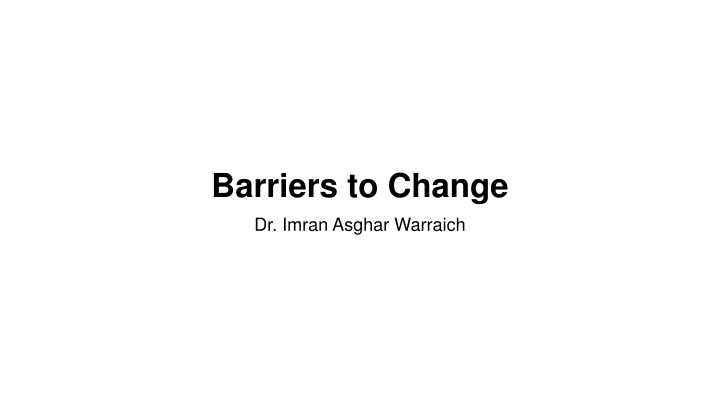
Barriers to Organizational Change
Learn about common barriers to change in organizations and how companies often fail to react to threatening changes, leading to crises and even insolvency. Discover the factors influencing resistance to change and the consequences of refraining from adapting to new developments.
Download Presentation

Please find below an Image/Link to download the presentation.
The content on the website is provided AS IS for your information and personal use only. It may not be sold, licensed, or shared on other websites without obtaining consent from the author. If you encounter any issues during the download, it is possible that the publisher has removed the file from their server.
You are allowed to download the files provided on this website for personal or commercial use, subject to the condition that they are used lawfully. All files are the property of their respective owners.
The content on the website is provided AS IS for your information and personal use only. It may not be sold, licensed, or shared on other websites without obtaining consent from the author.
E N D
Presentation Transcript
Barriers to Change Dr. Imran Asghar Warraich
Typical Behavior of Companies in Crisis Situations Non- reaction to Change Kraus and Haghani come to the conclusion that more than two thirds of companies only show reactions to threatening changes in their environment after a slump in profits and sales has already occurred. Loewe, a German manufacturer televisions didn t reacted to the change in technology (Hence, Loewe filed for insolvency in October 2013) of high-end designer
American photo film producer Eastman Kodak had huge crisis in 2005 because it was surprised by the rapid spread of digital photography. Kodak also ended up in insolvency at the beginning of 2012, from which it was released in August 2013. However, with a completely new business model in which Kodak, as a technology provider, concentrates on digital image processing and printing systems for business customers.
The Finnish technology group Nokia was the world market leader in mobile phones for more than a decade. However, with the market entry of the American IT giant Apple and its iPhone, the market changed fundamentally. Not only did Apple achieve even higher scores in terms of design and brand image, but they were now ahead of Nokia in technologies such as the touch screen, but only on the market. In its development laboratories, Nokia had produced similar user-friendly devices with touch screens years earlier, but had clearly overlooked the potential in connection with mobile Internet services. In autumn 2013, Nokia s mobile phone division was sold to Microsoft.
Three typical phases of a companys crisis-prone development
Pressure to act and scope for action in crisis situations (based on Kraus and Haghani 2004,p. 16)
Barriers to Change Refraining from change can therefore be expensive and often have consequences that threaten the very existence of the company. But how is it that companies, which are run by experienced managers and may even seek expert advice, do not take apparently easily foreseeable developments into account? It will be shown that often a mixture of several factors is responsible, which are to be found in the area of the acting persons (individual causes), the company as a whole (collective causes),misunderstood cost avoidance (economic causes) or an uncertainty about the (complexity). effect of change measures
Individual Causes Humans tend to avoid decisions. From a behavioral science perspective, two approaches can be used to explain such a decisional delay: (1) the concept of avoidance of cognitive dissonance and (2) the so-called satisficing -behavior. 1. The concept of avoidance of cognitive dissonance: In essence, it says that people strive to have a world of thought that is as harmonious as possible, in which the contents of consciousness (cognitions) do not contradict each other. If contradictions occur in the world of perception, people perceive this as a tense, unpleasant state, which they try to avoid. On the one hand, the individual threatened by dissonance can try to simply fade out, virtually eliminate the dissonant information (e.g., the rapid spread of digital photography). Or another frequently chosen strategy is preferred, which consists in devaluing dissonant information, for example by questioning the competence of the source. The second basic way of reducing mental pain through dissonant information is to actively search for information that supports previous thinking, so-called consonant information.
2. Satisficing behavior: Satisficing refers to a type of behavior from the field of so-called bounded rationality, described by the Nobel Prize winner in economics Herbert A. Simon.3Behavior is considered to be of bounded rationality if it is characterized by the attempt to act rationally, but this rationality is restricted by limitations of the human brain s ability to think and perceive. The basis of these considerations is the fact that the human brain is only capable of simultaneously processing five to nine sensory units.
Optimal decision-making behavior in contrast to satisficing
Self-Test for Bounded Rationality Carry out the following experiment for yourself: Read through the following series of numbers once, then cover them up and write down the memorized numbers in the correct order. 8 1 7 3 4 9 4 2 8 5 How many numbers have you memorized in the correct order? As a rule, it should be between five and eight numbers.
Collective Causes Companies as social entities can be subjected to a double consideration: On the one hand, by looking at their formal organization, the part that officially regulates the relations between the members of a company. On the other hand, in addition to the official, formal phenomena, the informal, not explicitly apparent rules of conduct are more important incases of doubt. These informal codes of behavior and thinking, which are not usually written down, are also known as corporate culture. Under certain circumstances, both these sources can induce inertia in the acceptance of necessary change, as will be shown in the following.
1. Barriers to change through formal organizational criteria: Empirical Studies have investigated the conditions under which organizations tend to avoid change. organizations are characterized by a high degree of centralization and highly formalized processes. At the same time, status and income differences in the hierarchy play organizational principles are often accompanied by a high production volume (i.e., mass production) and a predominance of the efficiency objective, for example in the form of a pronounced cost orientation. According to this, such a significant role. These
2. Inhibited change through strong corporate cultures: In addition to hard organizational criteria, soft factors in the form of corporate culture also play a significant role in explaining delayed change. Today, a strong corporate culture is recognized as one of the key success factors for successful corporate management.
Strength of the Culture The strength of the culture depends on three factors:7 The conciseness of a culture: This factor includes, on the one hand, the fact that corporate culture regulates almost all areas relevant to the daily activities of a company through the norms and values of the culture. On the other hand, conciseness also means the enthusiasm of the people involved in the culture as such. The degree of diffusion of the culture: A culture is widespread when almost all members of an organization share it, that is, act according to the same patterns of values and norms. The anchoring depth: Cultures are particularly effective when their rules are followed without conscious thought. Psychologists speak of internalization in this case. As a rule, the earlier in life norms are internalized, the more internalized they are. For this reason, companies with strongly developed cultures often have a tendency to recruit junior management staff directly from the classroom (e.g., at the fashion retailer C&A) or from the university (e.g., at grocery chain Aldi) and to fill management positions later almost Overconfidence at Nokia The abovementioned example of Nokia can be used here again as proof. exclusively from their own ranks.
Economic Causes If non-psychological or organizational factors are responsible for the failure to change, apparently rational, economic arguments are often used to maintain the existing situation. Change is associated with costs, and at the same time change can render investments already made obsolete. Two cost aspects can be distinguished here, firstly the direct costs arising from the change itself and secondly investments, for example through considered in the following. the devaluation non-use. of previous will Both be
1. Change itself generates numerous types of costs: These include investments in fixed assets, the introduction of new business processes, necessary training for employees, as well as recruitment, and if necessary, redundancy costs. The general problem with change processes is that these costs are incurred at the beginning of a project or are at least foreseeable. Rarely does it happen that change processes produce less cost than initially assumed; the opposite is more likely to be the case. On the other hand, the benefits of change are uncertain. They are based on the hypothesis that the path to be followed is the right one, an assumption that is not entirely correct in view of the complexity of today s inherently uncertain markets. It is therefore all too easy to erroneously conclude that change will not happen. However, the opportunity costs of not doing so are ignored.
2. The second cost aspect occurs, when change threatens to render previous investments obsolete. Again, it is rather psychologically difficult to let go. It is known from business administration that investments already made are called sunk costs. This can be illustrated using the above Loewe case study as an example. One reason for the company not to believe in the rapid replacement of tube TVs by flat-panel TVs was its own investments in production facilities for just such tube sets. A change in company policy toward flat-panel TVs would have made all these systems useless . Will they become more valuable if the necessary change is not made? The answer is of course: No! Two things need to be considered here. Firstly, adherence to the current production policy will necessarily lead in the long term to a crisis that threatens the existence of the company, that is, the current production facilities will not be viable in the future either way and will therefore be devalued. Secondly, a change of direction, for example in the sense of moving toward flat-screen TVs, does not necessarily mean that investments made yesterday will be worthless overnight.
As long as a positive cash flow is generated with CRT setsin addition to the newly added flat-screen sets that is, the payments made for their production are lower than the sales revenues to be generated, the parallel continuation of the investment is worthwhile. Depreciations of the production facilities, as non-cash costs, are not to be included in this calculation, because the payments for them have been made and cannot be reversed in other words sunk costs.
Complexity While the factors listed so far, which are responsible for barriers to change, can be characterized for the most part as irrational or at least limitedly rational, this is not necessarily true for the last factor, complexity. Complexity refers to a property of system that makes it difficult to predict precisely what will happen after a change in such a system. In order to understand more precisely what is meant by this, it makes sense to consider companies environment surrounding them as systems (see Fig. 3.5) and the business
Systems Systems are complex, they are characterized by the following three properties: Networking This means that a system consists of many interdependent characteristics. That this applies to companies and their environment is probably sufficiently clear from the above. Dynamics It refers to the fact that reality changes independently, that is, without any action by the company. This is also unquestionably true for the corporate environment (social, technological, political, and economic change). In addition, companies also change internally without any initiated intervention. Last but not the least, almost every company also has competitors who initiate their own actions. Intransparency This characterizes the fact that not all features of reality are known. In view of the complexity and multitude of internal and external company developments, the existence of this third feature for companies can hardly be denied.






















